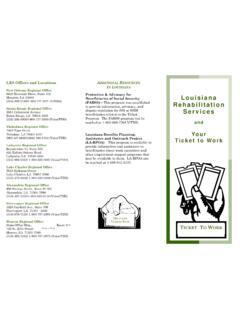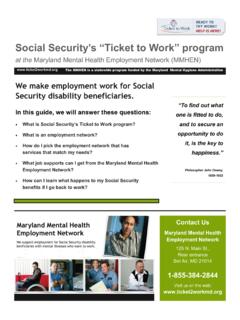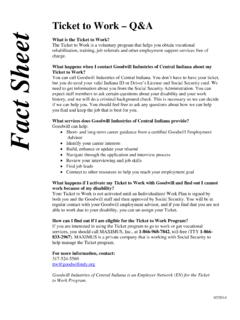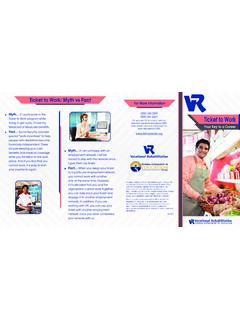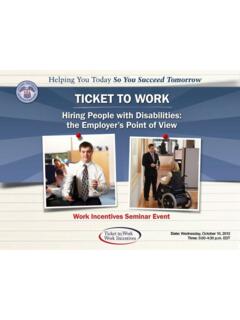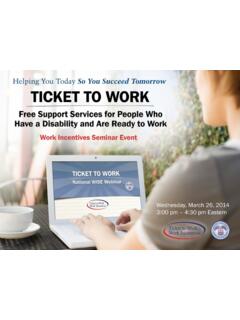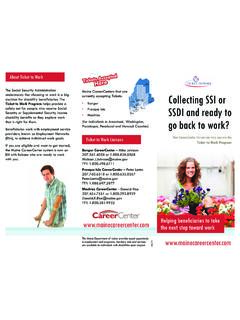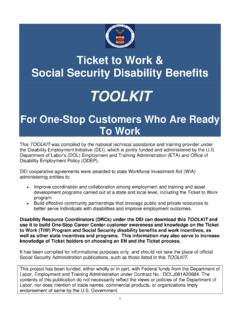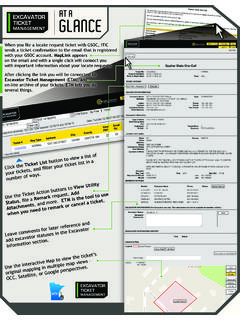Transcription of Chapter 107: Ticket to Work - vocrehab.vermont.gov
1 Chapter 107: Ticket to work Revised: October 2015 Policy and Procedures Manual | Division of Vocational Rehabilitation | State of Vermont page 1 Chapter 107: Ticket to work Vermont Division of Vocational Rehabilitation Policy and Procedures Manual Revision Date: October 2015 THIS ENTIRE Chapter IS GUIDANCE Table of Contents Overview .. 2 Definitions .. 2 General Procedures .. 3 Continuing Disability Reviews (CDR) .. 4 Employment Network Partnerships .. 5 Changes in Procedures .. 5 Ticket to work , Frequently Asked Questions .. 6 Chapter 107: Ticket to work Revised: October 2015 Policy and Procedures Manual | Division of Vocational Rehabilitation | State of Vermont page 2 Overview The Ticket to work Program was created as part of the Ticket to work and work Incentives Improvement Act of 1999. Its purpose is to expand the number of service providers available to SSDI and SSI beneficiaries in obtaining services necessary to find, enter and retain employment.
2 The goal of the program is to reduce or eliminate their dependence on Social Security and SSI cash benefits. Under the Ticket to work Program, the Social Security Administration (SSA) pays Employment Networks (employment service providers) outcome and milestone payments if they assist SSI/SSDI beneficiaries become employed above defined income thresholds. DVR operates as an Employment Network under the Ticket to work program. Historically, the Ticket to work Program is an important source of revenue for DVR and these funds have helped fund services for DVR consumers. This is because DVR has been effective in helping beneficiaries return to work and increase their earnings. DVR receives payment when a beneficiary achieves the following milestones and outcomes: Phase I Milestones: Earnings at a Trial work Level for one, three, six and nine months.
3 Phase II Milestones: Each month of earnings at a Substantial Gainful Activity level (for 11 months for SSDI beneficiaries and 18 months for SSI beneficiaries). Outcomes: Each month the beneficiary receives a zero benefit as a result of work activity (for 36 months for SSDI beneficiaries and 60 months for SSI beneficiaries). Definitions Ticket to work is a document provided by the SSA to Social Security Disability Insurance (SSDI) and Supplemental Security Income (SSI) beneficiaries that they can use to access employment services, vocational rehabilitation services and other support services to enable them to go to work . Services can be obtained from state VR agencies and other qualified Employment Networks. Maximus is the organization Social Security has hired to assist in the administration of the Ticket Program.
4 Continuing Disability Review (CDR) SSA reviews disability cases periodically to see if the person with a disability still meets disability criteria. SSA performs two types of reviews, a medical continuing disability review and a work continuing disability review. Under a work review, SSA looks at earnings to determine if an individual is eligible for monthly benefits. A medical review determines if an individual is meeting the medical requirements to collect disability. If the person does not meet the medical requirements, SSA may stop the disability benefits. Chapter 107: Ticket to work Revised: October 2015 Policy and Procedures Manual | Division of Vocational Rehabilitation | State of Vermont page 3 Employment Network An Employment Network is an organization or individual who provides employment services under the Ticket to work program.
5 General Procedures The following are guidelines for VR counselors for the Ticket to work Program. It is important to note that the Ticket Program is an SSA program that is administered by SSA and their contractors. The payment mechanisms built into the program should not influence the DVR rehabilitation counseling process. The DVR consumer s wishes, goals, skills and aptitudes should drive his/her choices regarding their employment goal and how much they want to work and earn. Ticket Assignment is automatic at the point the IPE is signed. When an individual who receives SSI or SSDI signs an IPE, SSA considers that their Ticket to work is In Use . That is to say, by choosing to seek DVR services and signing an IPE, they have also chosen to activate their Ticket to work . You do not need to take any action. DVR is required to inform SSA when an SSI or SSDI beneficiary signs an IPE.
6 This process is completed electronically through Central Office. It is very important that you have the correct Social Security Number entered in the VR database, or the consumer s Ticket will not be assigned to DVR. If you do not get the Social Security Number at application, you must try to get it entered prior to the IPE date. SSA s contractor Maximus will send a letter to the DVR consumer informing them they have assigned their Ticket to DVR. How should I explain the Ticket to work to my consumer? Use the Ticket to work FAQ for DVR Consumers ( Section VII) to explain the program. Explain to the DVR consumer that it will not affect his/her DVR services in any way. Explain to the DVR consumer that DVR can receive payment if they go to work above the thresholds for payment. However, how much they work is entirely their choice.
7 If DVR does receive payment under the Ticket to work , any money received goes toward services for other DVR consumers. Explain to the consumer that, by assigning their Ticket through participation in the DVR program, they will receive suspension of SSA medical reviews for a minimum of one year. This only applies if this is the first time the consumer has ever assigned their Ticket . Chapter 107: Ticket to work Revised: October 2015 Policy and Procedures Manual | Division of Vocational Rehabilitation | State of Vermont page 4 If appropriate, encourage the consumer to consult with a benefits counselor regarding the potential impact of the employment plan on his/her benefits and healthcare coverage. What if the consumer really does not want to have their Ticket assigned to DVR? The beneficiary can contact Maximus and request their Ticket to work be unassigned.
8 However, as noted in the prior section, when an SSI/SSDI beneficiary signs a DVR IPE, SSA considers that Ticket In Use . In these cases, DVR can still potentially receive payment under the SSA cost reimbursement program. What if the consumer has assigned the Ticket to another Employment Network? DVR will report the Ticket as In Use with DVR to SSA. The Ticket to work will be reassigned to DVR. DVR may have to share potential payments with the other Employment Network. What if a consumer becomes Ticket eligible after they have signed their IPE? It is not unusual for a DVR consumer to start receiving benefits after they have signed an IPE. DVR will report the Ticket to work as In Use to SSA. The effective date will be at the point the individual became eligible for SSI/SSDI benefits. Continuing Disability Reviews (CDR) SSA reviews disability cases periodically to see if the person with a disability still meets disability eligibility criteria.
9 SSA performs two types of reviews, a medical continuing disability review and a work continuing disability review. Under a work review, SSA looks at earnings to determine if an individual is eligible for monthly benefits. A medical review determines if an individual is meeting the medical requirements to collect disability. If the person does not meet the medical requirements, SSA may stop the disability benefits. Under the Ticket to work program, when a consumer assigns his/her Ticket to VR (or another Employment Network), SSA will not do a medical CDR for one year following the date of his/her Ticket assignment. SSA will suspend medical CDRs for up to five additional years if the beneficiary is considered to be making timely progress. Timely progress is defined as follows: Timeline Required benchmarks for timely progress to continue suspension of Medical Reviews By End of Year One Three months of work at a Trial work Level (defined by SSA) or 60% of full-time participation in a post-secondary education or vocational training program.
10 Chapter 107: Ticket to work Revised: October 2015 Policy and Procedures Manual | Division of Vocational Rehabilitation | State of Vermont page 5 Timeline Required benchmarks for timely progress to continue suspension of Medical Reviews By End of Year Two Six months of work at a Trial work Level (defined by SSA) or 75% of full time participation in a post-secondary education or vocational training program. By End of Year Three Nine months of work at a Substantial Gainful Activity level (defined by SSA) or completion of a two-year degree. By End of Year Four Nine months of work at a Substantial Gainful Activity level (defined by SSA) or completion of an additional year of post-secondary education. By End of Year Five Six months at zero benefits as a result of employment or completion of an additional year of post-secondary education.
